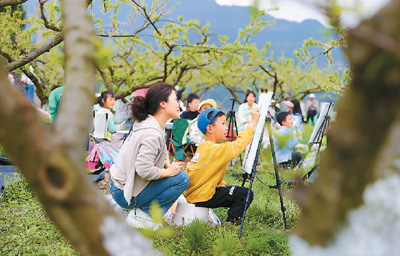China’s Ministry of Agriculture and Rural Affairs recently held a spring-themed event to promote rural leisure tourism, unveiling 60 tourist routes and 185 scenic spots.
Rural areas have become popular domestic destinations for Chinese tourists. During the three-day Qingming Festival holiday that ended on April 6, travel orders in rural areas jumped 239 percent year-on-year, according to China’s online travel agency Ctrip.

People enjoy pear blossoms in Huaibei City, East China’s Anhui Province. (Photo/Feng Shufeng)
In recent years, rural tourism in China has entered a fast lane of development. Regions across the country are constantly improving infrastructure such as roads, electricity, water supply and rural communications, and also build rural book houses, reading rooms, activity halls, rural stages and other cultural facilities. They have also developed various forms of tourism, giving rural tourism a deeper meaning.
Rural areas have once again become places that tourists are eager to visit as they can appreciate the pristine natural scenery while experiencing the vibrant atmosphere through rural tourism.
Thanks to the integration of ecology and tourism in many places in China, a growing number of people who previously worked outside their hometowns are returning to start businesses.
For example, several tea-themed tourist destinations, including the cities of Hanzhong and Ankang in the southern part of northwest China’s Shaanxi Province, have launched tourism products related to tea leaf picking, allowing tourists to experience the fun of supervised tea picking and the charm of tea culture .
Jingmai Mountain in Lancang Lahu Autonomous County, Pu’er, southwest China’s Yunnan Province, is entering the spring tea harvest season. The Jingmai Mountain Ancient Tea Forest Cultural Landscape was inscribed on the UNESCO World Heritage List in 2023.

Children paint at a plum farm in southwest China’s Chongqing Municipality. (Photo/Yang Min)
The tea industry has become a sector that is now bringing wealth to the people. This year, the county’s production of dry raw tea is expected to reach 35,000 tons, with an estimated output value of more than 8 billion yuan (about 1.1 billion US dollars).
In the village of Changdai, Hangzhou, the capital of East China’s Zhejiang province, tea has brought wealth to both local tea growers and workers engaged in picking tea from other regions. Located in the central area of the West Lake Longjing Protected Tea Origin, the village boasts 1,496 mu (about 99.73 hectares) of tea gardens. There are currently 360 households growing tea in the village. During this year’s spring tea harvest season, over 3,000 workers came to the village to pick tea leaves.
A good environment has become a “golden calling card” for rural development. Villagers have paid more attention to environmental protection and environmental management, contributing to the construction of a beautiful scenery with stable ecology, wealthy people and thriving industries.
Tourists can enjoy blooming peach blossoms, fly kites and taste peach blossom wine at an ecological garden in Shuipoya Village, Wenshang County, East China’s Shandong Province.
Once a dirty and unkempt place, the ecological garden has now become a popular tourist destination following the village’s efforts to improve road and watercourse conditions, encourage large-scale peach planting, and combine sightseeing and agriculture.
The village is just one shining example of a development path characterized by a stable ecology, thriving industries and wealthy people in the county.
(Web Editor: Hongyu, Liang Jun)

